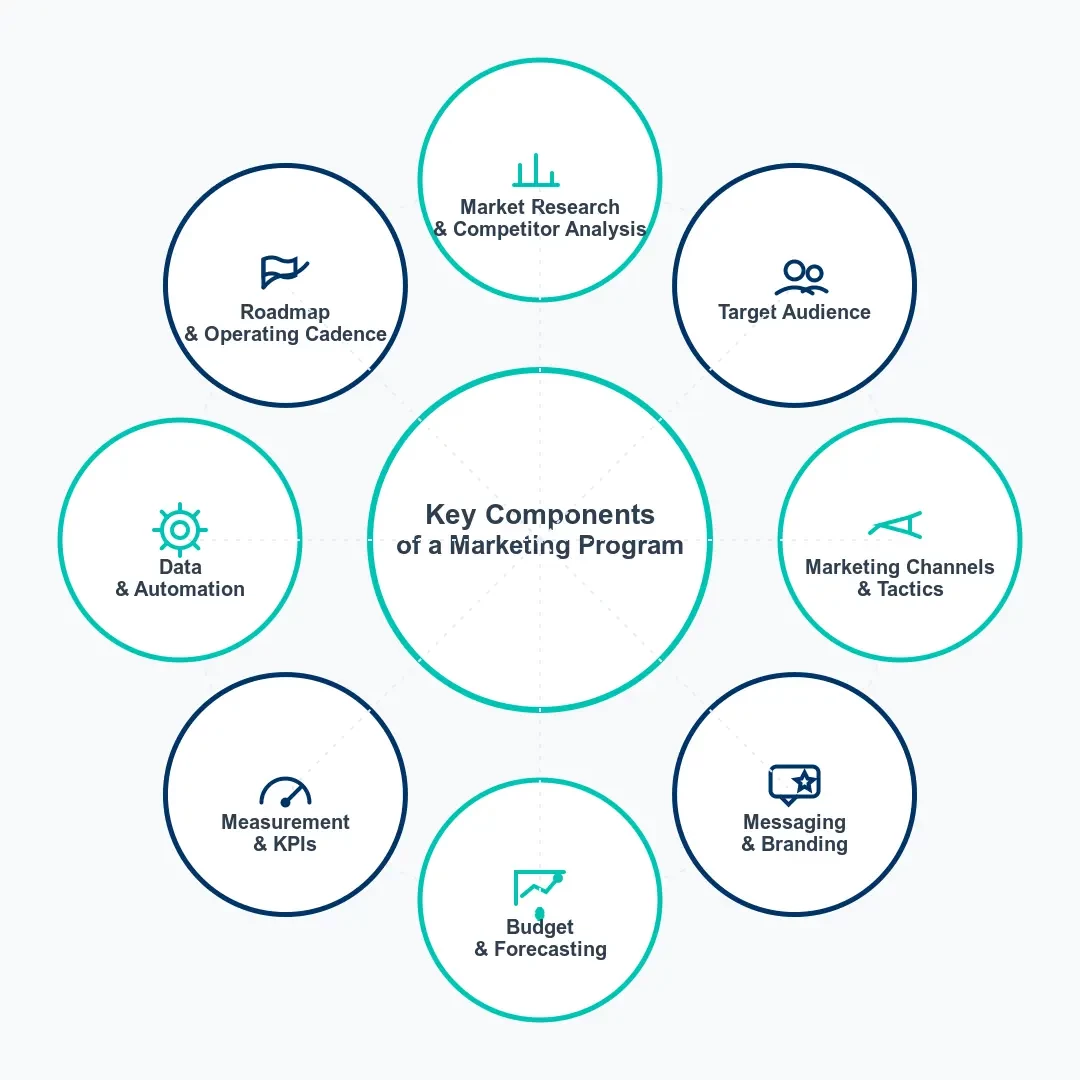Marketing Program
If you’ve wondered how campaigns, channels, and budgets click together, this is for you. This glossary entry explains what a marketing program is, how it runs, and how to build one that works.
What Is a Marketing Program?
A marketing program is the coordinated, ongoing system that organizes marketing activities to achieve business goals. When a marketing campaign is time-boxed and thematic, the marketing program continues to run, guiding multiple campaigns so they contribute to results rather than noise.
The system provides practical guidance about your target audience, service commitment and contact channels, budget allocation, and performance evaluation methods. The system connects business targets such as revenue, profit, and customer retention to marketing elements, which enables you to track every activity through measurable outcomes.
Because it’s systematic, a marketing program keeps creative, media, analytics, CRM, and sales enablement moving in sync.
How Does a Marketing Program Work?
A marketing program works like a flywheel. It begins with market research and audience segmentation, spins up coordinated work across digital marketing channels, and accelerates through feedback loops that sharpen what you do next.
The first thing that the program does is turn business goals into marketing goals, such as getting more people to know about the company, getting more leads, increasing the conversion rate, or keeping customers. Then it connects messages to the many stages of the customer lifecycle: discovery, evaluation, purchase, onboarding, and growth. Each step receives its own message and offer.
Execution spans the spectrum: content marketing for education, search engine optimization (SEO) for intent capture, pay-per-click advertising (PPC) and online advertising for demand, social media marketing for reach, email marketing and customer relationship management (CRM) for nurturing, plus PR and branding. In omnichannel marketing, the marketing program unifies touchpoints so customers see one brand and experience consistent personalization across the site, app, inbox, ads, and store.
Example: Sephora's Beauty Insider is a part of a marketing program that includes loyalty in its emails, tips, and promotions. Allbirds uses product drops, narrative sites, and email marketing to establish the brand and move inventory at the same time.
Measurement keeps the wheel spinning. The marketing program uses KPIs—CPA, return on investment (ROI), ROAS, LTV:CAC, and return on sales—to refine budgets, messages, and user segmentation. The cadence is simple: plan → execute → analyze → optimize.
Benefits of a Marketing Program
Clear direction and alignment
A marketing program turns broad goals into a single source of truth. Teams work on a shared roadmap that integrates promotional strategy, channel roles, your advertising plan, and KPIs.
Cohesive customer experience
Because the framework spans creative, media, and CRM, customers encounter one coordinated story from ad click to checkout.
Better ROI and stronger return on sales
A mature marketing program allocates spend based on evidence. Budgets flow to winners, underperformers get fixed or paused, and resources shift to touchpoints that move the needle. The payoff: higher ROI and healthier return on sales.
Predictable pipeline and retention
By mapping initiatives to the customer lifecycle, the marketing program doesn’t stop at the sale. It nurtures onboarding, cross-sell, and loyalty. Nike’s SNKRS app shows how push alerts, content, and early access support steady demand between big launches.
Faster learning loops
When everything runs in one framework, insights spread fast. A headline that boosts search CTR can inform an email marketing subject line; a landing page that lifts conversion rate can reshape social ads.
Key Components of a Marketing Program

Market Research & Competitor Analysis
Use market research to size demand, learn from adjacent categories, and validate needs through interviews, surveys, and on-site behavior. Add competitor analysis—positioning, pricing, messaging, and ad footprints—to spot gaps you can own.
Target Audience, Buyer Personas & User Segmentation
Define the target audience with data, not hunches. Build buyer persona profiles that capture motivations and objections. Apply user segmentation by behavior, lifecycle stage, RFM, and predicted value. Segmentation enables personalization at scale.
Marketing Channels & Tactics
Spell out channel roles. For discovery, lean on content marketing, PR, and social. For capture, deploy SEO, PPC, and online advertising. For nurturing, orchestrate email marketing, SMS, and on-site messaging in your CRM. In omnichannel marketing, connect these touchpoints so customers can start in one channel and finish in another without friction.
Messaging, Positioning & Branding
Codify the value proposition, tone, and proof. The marketing program should include message hierarchies tied to lifecycle stages and persona needs, so relevance holds whether someone is learning, comparing, or ready to buy.
Budget Allocation & Forecasting
Translate objectives into a marketing budget, linking spend to expected results. Include working media, production, tools, and staffing. Forecast base, upside, and downside scenarios, and define rules for reallocating spend based on KPIs.
Measurement: KPIs, Dashboards & Governance
Pick key performance indicators (KPIs) for awareness, acquisition, revenue, efficiency (return on sales, ROI, ROAS), and retention. Establish dashboards and a governance cadence—weekly readouts, monthly deep dives, quarterly reviews.
Data, Tools & Automation
List the analytics, attribution, and automation tools powering the marketing program: web analytics, tag management, ad platforms, marketing automation, and product analytics. Ensure data flows cleanly so personalization and lifecycle triggers fire reliably.
Roadmap & Operating Cadence
Define owners, QA, and approvals for launches and campaigns.
Marketing Program vs. Marketing Campaign
A marketing campaign is a brief endeavor with a set topic, budget, target, and time frame. For example, a two-month back-to-school push using PPC, social advertisements, and a landing page. The marketing program is the big mechanism that makes sure all the campaigns work together toward the same goals, utilize the same messaging, and report to the same KPIs.
It also helps to separate a marketing plan from a marketing strategy. Your marketing strategy explains where you’ll compete and how you’ll win (positioning, differentiation, long-term choices). Your marketing plan documents the annual or quarterly tactics and resources. The marketing program is how strategy and plan get executed continuously—where decisions become operating routines and results. In short, strategy is the “why,” the plan is the “what,” and the marketing program is the “how” in motion.
How to Create a Marketing Program
1) Translate business goals into marketing objectives
Restate company targets—revenue, margin, market share—into quantifiable objectives that the marketing program can own. Tie each objective to a timeframe and to KPIs you can measure weekly.
2) Audit your current footprint and data quality
Inventory performance by channel and audience. Fix tracking breaks, fuzzy attribution, and CRM gaps before scaling spend.
3) Research the market and customer jobs-to-be-done
Interview customers; analyze search queries; map competitive offers. For online retail, study seasonality, price elasticity, and returns. Let these insights assign clear jobs to each channel.
4) Define audiences, personas, and segmentation

Create audience segmentation slices like first-time buyers, loyalists, cart abandoners, and dormant customers. In ecommerce, pair segmentation with product affinity and margin tiers to prioritize profitable demand.
5) Choose channel roles and craft the message architecture
Assign jobs to each channel: SEO for evergreen intent, PPC for rapid testing and demand capture, social for reach and community, email marketing and CRM for lifecycle revenue, PR for credibility. Draft message hierarchies by lifecycle stage and persona.
6) Build the budget, forecast, and guardrails
Allocate the marketing budget by objective and channel. Reserve a testing budget, and pre-define pause/scale rules based on CPA or return on sales. Account for inventory and cash-flow constraints in online retail so promos don’t outpace fulfillment.
7) Orchestrate omnichannel journeys and personalization

Design journeys that connect ads, site, and CRM. Use personalization—dynamic product blocks, price-drop alerts, replenishment reminders—to lift relevance. In omnichannel marketing, ensure identity resolution so a person who clicks a social ad receives a synchronized welcome flow and consistent on-site recommendations.
Example: Warby Parker blends Instagram, retargeting, and try-at-home emails in one flow. The story stays consistent from ad to quiz to checkout.
8) Implement measurement and dashboards
Define KPIs for each objective—conversion rate, AOV, lead quality, retention. Build dashboards that report weekly and drill down to creative, audience, and placement.
9) Launch, learn, and optimize continuously
Use holdouts or matched-market tests to validate lift. Include a recurring review where underperforming tactics are iterated or sunset, and budget flows to proven winners.
10) Ecommerce-specific moves worth stealing
Integrate product feeds with search, social, and email marketing so pricing and availability stay current. Pair lifecycle messages—browse/cart/price-drop/low-stock—with user segmentation to protect margin on hero SKUs while clearing long-tail inventory. Use first-party data for predictive replenishment and send post-purchase care that nudges reviews and referrals. Track profitability, not just top-line revenue: monitor contribution margin and return on sales per campaign so the program scales profitably.
Final Thoughts
The organized process of transforming concepts into measurable results operates as the core growth mechanism known as a marketing program. It provides teams with focused direction while maintaining customer experience consistency and accumulating knowledge across different communication channels. Your marketing program will establish a lasting system for customer awareness, acquisition, and loyalty through disciplined research, precise segmentation, effective channel management, and continuous measurement.
And while a marketing plan and a marketing strategy remain essential—and your marketing plan may change quarter to quarter—it’s the marketing program that carries the work across weeks and quarters, steadily improving ROI and return on sales. The reliability of online retail depends on inventory movement that occurs when specific customers encounter suitable promotions during their appropriate shopping moments repeatedly. Once you establish the system it will operate continuously through your marketing program to maintain the flywheel's operation.
Join Our Blog Newsletter!
Stay updated with our latest email marketing tips, product news and case studies.